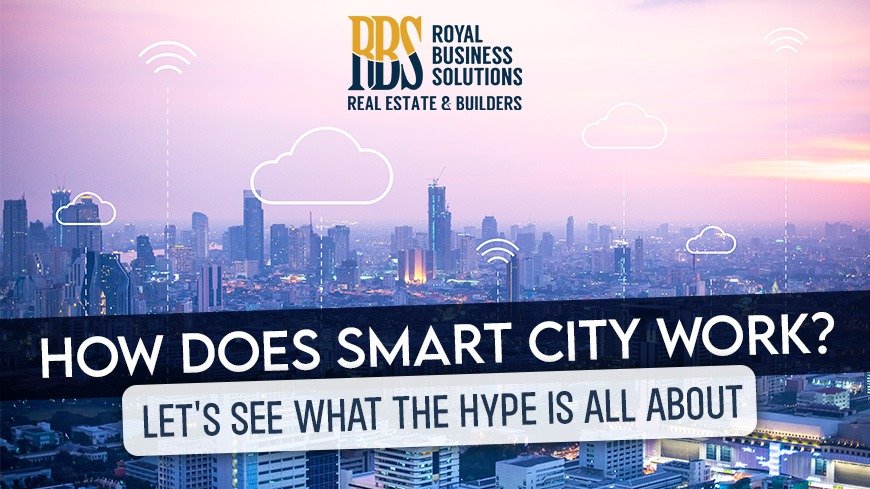- June 19, 2023
- Posted by: Muhammad Shehzad
- Category: Blogs

Introduction to a Smart City
As the world rapidly urbanizes, the concept of Smart Cities has gained significant attention. Smart Cities leverage technology and data to create more efficient, sustainable, and livable urban environments. With the promise of enhanced quality of life, improved infrastructure, and increased connectivity, Smart Cities have become a global phenomenon. In this blog, we will delve into the workings of a Smart City, exploring the key components, benefits, and challenges associated with this transformative urban concept.
Understanding Smart Cities
1.1 Defining a Smart City:
Smart Cities are urban areas that utilize cutting-edge technologies, data analytics, and Internet of Things (IoT) devices to optimize and streamline various aspects of city life. These technologies are employed to enhance efficiency, sustainability, safety, and overall livability for residents. Smart Cities aim to create connected ecosystems that improve resource management, mobility, governance, and citizen engagement.
1.2 Key Components of a Smart City:
Smart Cities consist of several interconnected components that work together to create an intelligent urban environment. These components include:
1.2.1 Internet of Things (IoT):
The IoT plays a crucial role in Smart Cities by connecting various devices, sensors, and infrastructure to gather data. This data is then analyzed to derive insights and drive informed decision-making for better resource allocation, traffic management, and service delivery.
1.2.2 Data Analytics and Artificial Intelligence (AI):
Smart Cities rely on advanced data analytics and AI algorithms to process the vast amounts of data generated by IoT devices. These technologies enable predictive analysis, real-time monitoring, and automation to optimize city operations and improve the quality of services provided to residents.
1.2.3 Intelligent Infrastructure:
Smart Cities integrate intelligent infrastructure systems such as smart grids, smart buildings, and smart transportation networks. These systems use sensors, automation, and connectivity to optimize energy consumption, reduce environmental impact, and enhance the overall functionality of urban infrastructure.
1.2.4 Citizen Engagement and Participation:
Citizen engagement is a fundamental aspect of Smart Cities. Through digital platforms, mobile applications, and community participation, residents can actively contribute to decision-making processes, provide feedback, and collaborate with local authorities to address urban challenges effectively.
The Benefits of a Smart City
2.1 Enhanced Quality of Life:
Smart Cities aim to improve the quality of life for residents by providing efficient transportation systems, sustainable energy solutions, advanced healthcare services, and seamless connectivity. By leveraging technology, cities can offer better public services, reduce congestion, and create safer environments.
2.2 Sustainable Development:
Smart Cities prioritize sustainable development by optimizing resource utilization and reducing carbon footprint. Through smart energy grids, waste management systems, and eco-friendly infrastructure, cities can minimize environmental impact and promote a greener, more sustainable future.
2.3 Improved Efficiency and Infrastructure:
By using real-time data and analytics, Smart Cities can optimize infrastructure management and maintenance. Intelligent traffic systems, smart parking solutions, and automated public transportation can significantly improve mobility and reduce congestion, enhancing the overall efficiency of urban transportation networks.
2.4 Economic Growth and Innovation:
Smart Cities foster economic growth by attracting businesses, entrepreneurs, and investors. The integration of technology, research, and innovation hubs creates opportunities for job creation, entrepreneurship, and the development of digital industries.
Challenges and Considerations of a Smart City
3.1 Data Privacy and Security:
As Smart Cities rely heavily on data collection and analytics, ensuring the privacy and security of personal information is of utmost importance. Robust cybersecurity measures and data protection regulations are essential to safeguard citizen data and maintain public trust.
3.2 Digital Divide:
The digital divide, referring to the gap between those who have access to technology and those who don’t, can pose challenges in implementing initiatives. Addressing this divide requires proactive measures to provide equal access to digital infrastructure and ensure inclusivity for all residents.
3.3 Cost and Funding of a Smart City:
Implementing Smart City solutions can be financially demanding. Adequate funding models, public-private partnerships, and long-term planning are necessary to overcome the financial challenges associated with building and maintaining Smart Cities.
Successful Smart City Examples
4.1 Lahore Smart City – Transforming Lahore’s Urban Landscape:
Lahore Smart City is a notable example of a successful Smart City initiative. Located in Lahore, Pakistan, this ambitious project aims to revolutionize the city’s infrastructure, services, and quality of life for its residents. Lahore Smart City incorporates state-of-the-art technology, sustainable practices, and modern urban planning principles.
Read: Step-By-Step Guide To Lahore Smart City Booking Procedure
4.2 Capital Smart City – Redefining Urban Living:
Smart City, situated near Islamabad, Pakistan, has emerged as a prime example of a successful Smart City development. This visionary project encompasses cutting-edge technology, green initiatives, and smart solutions to offer a modern and sustainable living experience.
This project integrates intelligent transportation systems, energy-efficient infrastructure, and digital connectivity to optimize resource usage and enhance quality of life. The project emphasizes sustainable practices, including smart waste management, renewable energy integration, and green spaces. With its focus on innovation and sustainability, Capital Smart City is setting new standards for urban development in Pakistan.
Furthermore, you can invest in Capital Smart City through RBS! Link at the bottom.
The Future of Smart Cities
Smart Cities represent the future of urban living. As technology continues to advance, the potential for innovation and transformation within cities is limitless. The integration of 5G networks, artificial intelligence, and sustainable solutions will further propel the development of Smart Cities, creating more connected, resilient, and livable urban environments.
Conclusion
Smart Cities offer tremendous opportunities to revolutionize urban living. By leveraging technology, data, and citizen engagement, cities can tackle challenges and build sustainable, efficient, and inclusive communities. As the hype around Smart Cities grows, it’s crucial for policymakers, urban planners, and citizens to grasp the underlying mechanisms and considerations. Embracing principles and innovative solutions will pave the way for a brighter, connected future for urban dwellers worldwide.
To further stay informed about the latest developments regarding ‘How Does a Smart City Work? Exploring the Fascinating World of Urban Innovation’, we encourage you to stay connected with Royal Business Solutions, your trusted source for timely updates and valuable insights.
